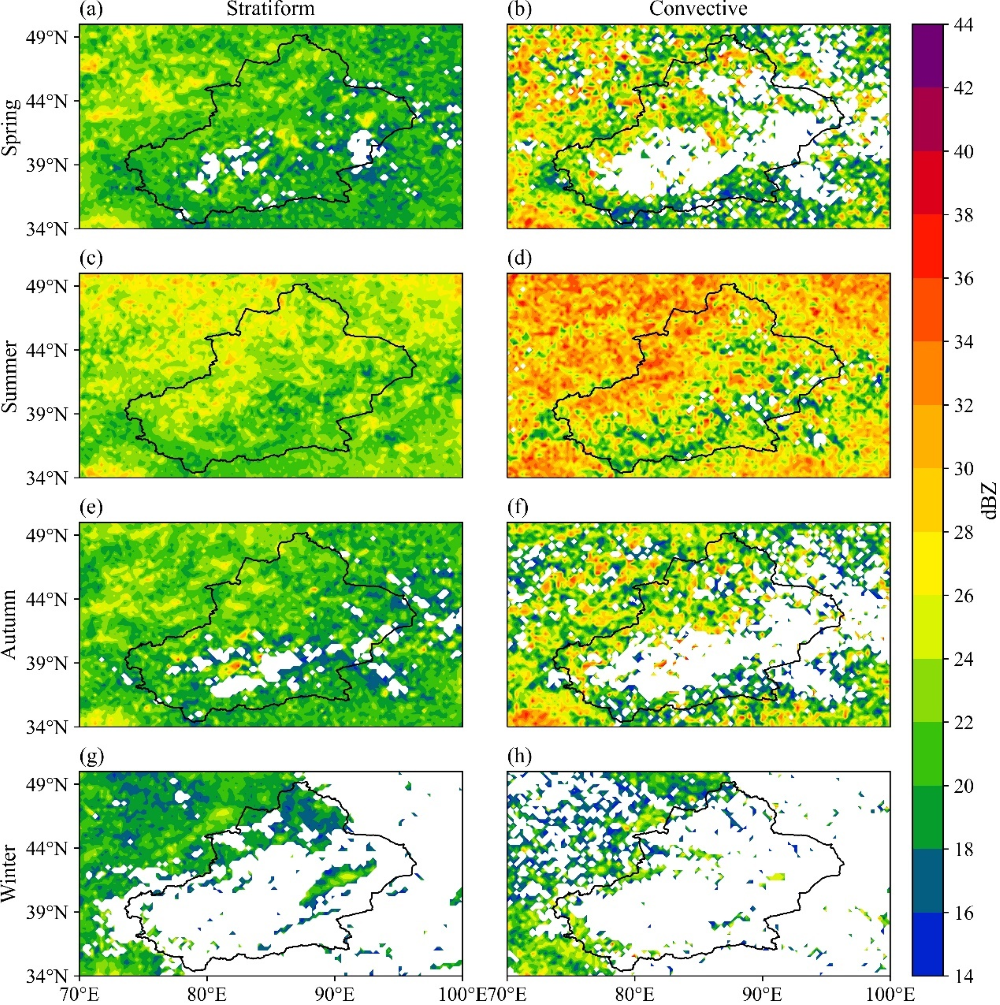
Research Highlight

The microphysical study of cloud precipitation over Xinjiang is constrained by the observation means due to the spatial distribution of precipitation and its inhomogeneity caused by its complex subsurface. The Global Precipitation Measurement (GPM) satellite carries a dual-frequency precipitation radar (DPR), which not only improves the three-dimensional observation of strong and weak precipitation, but also provides effective observation of alpine mountains.
Taking advantage of GPM/DPR, the Central Asia Weather Team at the Institute of Desert Meteorology, China Meteorological Administration (CMA), Urumqi, analyzes the precipitation characteristics of two types of stratiform and convective clouds in Xinjiang, using tertiary product data from January 2015-December 2022, and employing the methods of spatial projection and the contoured frequency by altitude diagrams (CFAD).

Figure: Seasonally averaged spatial distribution of maximum near-surface precipitation reflectivity factors for stratiform (a, c, e, g) and convective (b, d, f, h) precipitation.
The results show that the near-surface and different heights of precipitation echo ranges and maximum reflectivity factors for both types of precipitation in summer in Xinjiang are larger than those in other seasons, and that high value zones of maximum reflectivity factor occur along the Altai Mountains, Tianshan Mountains, and Kunlun Mountains as well as in the plains of their slopes. In summer, the maximum reflectivity factor of precipitation from stratiform clouds (convective clouds) near the ground is 22-32dBZ (29-41dBZ). The two types of precipitation storm top heights (STH) in summer are the highest, the convective cloud STH is higher than the stratiform cloud, and the STH over the mountainous area is higher than the surrounding basin due to the influence of topographic uplift. The value domains of precipitation echo reflectivity factor, particle mass-weighted diameter and ion concentration of stratiform clouds (convective clouds) are more concentrated (wider), i.e., the precipitation echo reflectivity factor is in the range of 14-30 dBZ (12-40 dBZ), the value domain of the particle mass-weighted diameter is in the range of 0.9-1.4 mm (0.7-2.1 mm), and the particle concentration is in the range of 29-35 (24-39). The height of the center of probability density of each covariate is higher in the three major mountain ranges than in the two major basins due to the influence of topography. Radar reflectivity increases and then decreases with height, and convective raindrops are in the active state of high concentration and large scale in the lower layers, whereas the particle spectral parameters of stratiform cloud precipitation show a more concentrated and symmetric distribution, accompanied by the height change is not significant.
The results are published in Advances in Meteorology as “Analysis of convective and stratiform precipitation characteristics in Xinjiang, China based on GPM dual-frequency precipitation radar”, and the first author of the paper is Xiaomeng Li. This research was supported by the “Tianshan Talents” cultivation program.
Original information: Li, X.M, Yang, L.M. *, Tong, Z.P., Li, H.Y., 2024. Analysis of convective and stratiform precipitation characteristics in Xinjiang, China based on GPM dual-frequency precipitation radar. Advances in Meteorology.
Link to article: https://doi.org/10.1155/2024/8043060

0991-2652429

desert@idm.cn

新疆维吾尔自治区乌鲁木齐市建国路327号


Scan to follow
us on WeChat